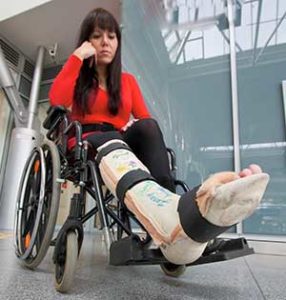
While many accident victims suffer serious injuries to their head, neck and spinal column, an accident-related leg, knee or foot injury can be just as life-altering. Fortunately, many victims of car and truck accidents walk away from the scene with a few minor injuries. However, others are not so lucky and sustain injuries that require immediate medical attention, hospitalization and follow-up care.
RI Accidents involving front end collisions, side-impact crashes, rollovers and ejections from the vehicle can cause a crushing blow to the driver or passengers. In addition to sustaining injuries to the upper body, the vulnerable lower extremities can also be severely damaged. Many victims suffer severe foot or leg fractures that cause extreme pain while limiting the individual’s ability to heal properly and return to work.
Thigh injuries in a motor vehicle accident
During a Providence car accident, the vehicle’s steering wheel and dashboard can easily break or crush the thigh bone of the driver or passengers riding in the front seat. These types of injuries are severe and require immediate transfer to a local area hospital for emergency care, multiple medical procedures and months of follow-up visits. A fractured femur often requires extensive surgeries where pieces of bone are pinned together to ensure the best healing. Successful surgeries require the femur to be well set and properly aligned with the knee and hip. If the bone is not set properly and quickly, there is often extensive permanent damage causing long-term issues with walking, running, standing and twisting movements.
Hip Injuries and foot injury
The harsh impact of a front-end Providence traffic collision often causes catastrophic injuries including damage to the hip bones and pelvis as well as foot injury. These crushing injuries are typically extremely painful during the healing process that could last for months and years after the accident. In some situations, the injured patient will display a hip joint dislocation that requires the surgical insertion of plates and screws to repair the fractured bone. Sometimes, the damage is extensive and requires a partial or full hip replacement followed by weeks of hospitalization, restricted mobility, extensive rehabilitation and months of pain and discomfort.
Knee Injuries
Any crushing injury to the knee is extremely painful, where the healing process can take many months to complete. In some situations, complete recovery is not possible because of extensive complications in rebuilding the broken bone and repairing the moving structure of the knee. Typical injuries involving an accident-related knee injury include:
• Ruptured tendon,
• Knee joint dislocation,
• Bone fracture,
• ACL (anterior cruciate ligament) damage caused by tearing or stretching,
• PCL (posterior collateral ligament) damage that causes swelling, pain and knee buckling when walking,
• Ligament hyperextension around the knee typically caused by a sudden impact to the joint or extreme twisting beyond its limits.
Ankle and Foot Injury
The ankles and feet are crucial load-bearing body parts that require strength, stability and flexibility to move, stand, jump and walk correctly. Unfortunately, traffic accidents often cause forceful impacts that place sudden extreme stress on the foot or ankle. Because of that, fractures occur easily, where broken bones require pins, plates and rods to hold the damaged areas together during healing. Often times, the accident victim’s broken bones require a long hard cast to keep the lower leg, ankle and foot in the correct position while healing.
Vehicular collisions can result in a wide range of injuries, including those affecting the legs, feet, and knees. These injuries can vary in severity depending on the speed and type of collision, whether the person was wearing a seatbelt, and other factors. Here are some common leg, foot, and knee injuries that can be caused by vehicular collisions:
- Fractures: Vehicular collisions can lead to fractures or breaks in the bones of the legs, feet, and knees. Common fractures include femur fractures, tibia and fibula fractures, and fractures of the foot and ankle bones.
- Dislocations: The force of a collision can cause joints in the legs and feet to become dislocated. This can be very painful and may require immediate medical attention.
- Soft Tissue Injuries: Soft tissues in the legs and knees, such as muscles, tendons, and ligaments, can be stretched, torn, or sprained in a collision. This can result in pain, swelling, and limited mobility.
- Contusions and Bruises: Impact with the interior of a vehicle or other objects during a collision can cause contusions and bruises on the legs and knees. While these may not be as severe as fractures or dislocations, they can still be painful and may indicate deeper tissue damage.
- Knee Injuries: The knees are particularly vulnerable during vehicular collisions. Injuries to the knee can include ligament tears (such as the anterior cruciate ligament or ACL), meniscus tears, and patellar fractures. These injuries often require surgical intervention.
- Crush Injuries: In severe collisions, the legs and feet can be subjected to crushing forces, which can lead to complex injuries, including compartment syndrome (due to increased pressure in muscle compartments), nerve damage, and damage to blood vessels.
- Amputations: In the most serious collisions, severe damage to the legs or feet can necessitate amputation. This is a life-altering and devastating outcome that often requires ongoing medical care and rehabilitation.
- Burns: If a vehicle catches fire or explodes, occupants may sustain burn injuries to their legs or feet.
- Post-Traumatic Stress Disorder (PTSD): While not a physical injury, it’s essential to acknowledge the psychological impact that vehicular collisions can have on individuals involved. PTSD can lead to emotional distress and have long-lasting effects on a person’s well-being.
It’s crucial for individuals involved in vehicular collisions to seek immediate medical attention, even if they don’t exhibit visible signs of injury, as some injuries may not manifest immediately. Prompt medical evaluation is essential for proper diagnosis and treatment. If you or someone you know has been involved in a vehicular collision, it’s advisable to contact law enforcement, file a police report, and consult with a healthcare provider to assess and treat any injuries. Legal and insurance considerations may also be relevant in such cases, depending on the circumstances of the collision.
Seeking Compensation in Providence Superior Court
RI car Accident-related leg and foot injuries often diminish the victim’s ability to perform everyday normal activities. In addition, the injured party often faces extensive medical bills, lost wages from time away from work, pain and suffering. However, they should not be required to pay for the negligent actions of the party that caused the accident. Because of that, they will often hire a skilled personal injury attorney who specializes in vehicle accident cases. A season Rhode Island personal injury attorney can provide valuable legal services including handling the claim or lawsuit for financial compensation. These vehicle collision types of cases causing knee injury are typically accepted on contingency, so you do not have to pay any upfront fees for legal services of the lawyers.

